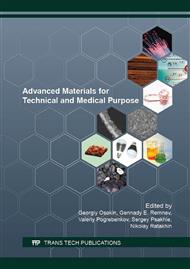[1]
M. N. Mohammed, M. Z. Omar, Z. Sajuri, M. S. Salleh, and K. S. Alhawari, Trend and Development of Semisolid Metal Joining Processing, Advances in Materials Science and Engineering., 2015 (2015), 846138.
DOI: 10.1155/2015/846138
Google Scholar
[2]
Handbook of Laser Welding Technologies, A volume in Woodhead Publishing Series in Electronic and Optical Materials, Elsevier Ltd., (2013).
Google Scholar
[3]
M. Vasiliev, A.T. Win, I. Pobol, New applications of beam-plasma systems for the materials production, International Journal of Nanotechnology, 11, (2014) 5/6/7/8, 660-668.
DOI: 10.1504/ijnt.2014.060588
Google Scholar
[4]
N.N. Rykalin, Energy sources used for welding, Welding in the World, Le Soudage Dans Le Monde, 12 (1974) 9-10, 227-248.
Google Scholar
[5]
N.N. Rykalin, A.A. Uglov, M.M. Nizametdinov, Calculation of the heating of materials by laser radiation allowing for the temperature dependences of thermal properties, Soviet journal of quantum electronics, 7 (1977) 7, 853-856.
DOI: 10.1070/qe1977v007n07abeh012665
Google Scholar
[6]
A.G. Knyazeva, I.L. Pobol, A.I. Gordienko, V.N. Demidov, O.N. Kryukova, I.G. Oleschuk, Simulation of thermophysical and physico-chemical processes occurring at coating formation in electron-beam technologies of surface modification of metallic materials, Physical Mesomechanics, 10 (2007).
DOI: 10.1016/j.physme.2007.08.010
Google Scholar
[7]
Comprehensive Hard Materials, Elsevier Ltd., 1 (2014) 3.
Google Scholar
[8]
J. Felba, K.P. Friedel, P. Krull, I.L. Pobol, H. Wohlfahrt, Electron beam activated brazing of cubic boron nitride to tungsten carbide cutting tools, Vacuum, 62 (2001) 171-180.
DOI: 10.1016/s0042-207x(01)00121-x
Google Scholar
[9]
V.G. Butov, D.V. Gubarkov, A.G. Knyazeva, Distribution of the diffusing element concentration in a three-layered system and estimation of the diffusion coefficient based on the solution of an inverse problem, Physical Mesomechanics, 6 (2000).
Google Scholar
[10]
A.G. Knyazeva, I.L. Pobol, V.A. Romanova, Stress field in the diffusion zone of an electron-beam brazed joint, Physical Mesomechanics, 4 (2001) 5, 41-53.
Google Scholar
[11]
V.G. Butov, D.V. Gubarkov, A.G. Knyazeva, I.L. Pobol, On the soldering optimization based on the theoretical study of the diffusion zone, Physical Mesomechanics, 5 (2002) 1, 89-93.
Google Scholar
[12]
B. Bokstein, S. Bokstein, A. Zhuchovitsky, Thermodynamics and kinetics of diffusion in solid bodies, Metallurgy, Moscow, (1974).
Google Scholar
[13]
M.A. Rahman, M.Z. Saghir, Thermodiffusion or Soret effect: Historical Review, International Journal of Heat and Mass Transfer, 73 (2014) 693–705.
DOI: 10.1016/j.ijheatmasstransfer.2014.02.057
Google Scholar
[14]
Y. Demirel, S.I. Sandler, Linear-nonequilibrium thermodynamics theory for coupled heat and mass transport, International Journal of Heat and Mass Transfer, 44 (2001) 2439-2451.
DOI: 10.1016/s0017-9310(00)00291-x
Google Scholar


